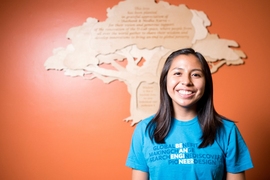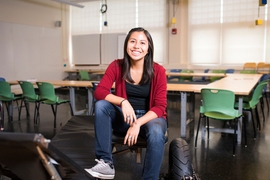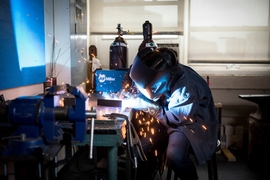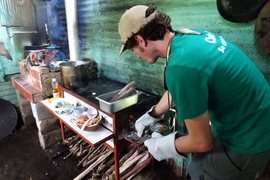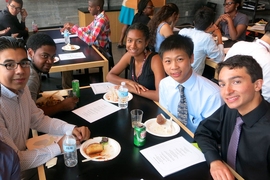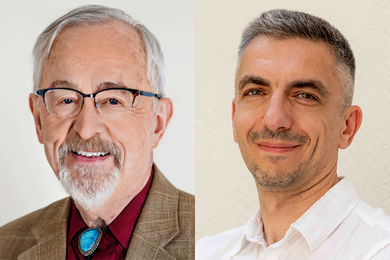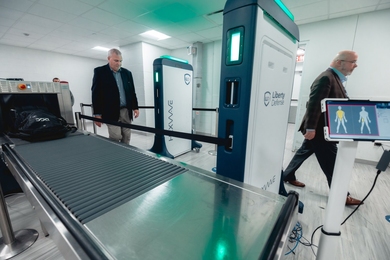Sade Nabahe’s time at MIT has been defined by engineering projects that help people around the globe with everyday problems. Even when seemingly straightforward ideas have proven tough to implement, she has stuck with them and remained committed to improving the quality of life for people living in poverty.
Originally drawn to MIT by an interest in prosthetics, as well as a general love for math and science, Nabahe is now a senior majoring in mechanical engineering. She has worked on projects for communities in Tanzania, India, Peru, and Lesotho, and has traveled to Peru to research, test, and implement several technologies that promote health and sustainability in local communities. She plans on finding a way to combine her engineering background and interest in global development to one day impact people’s lives through policy.
While Nabahe’s approach has shifted during the last four years, her overall aim has stayed the same: “My overarching goal in life has been to, no matter what, help people.”
MIT ambassador
Nabahe, who is originally from Tucson, Arizona, fell in love with the fast-paced engineering culture at MIT when she attended the six-week Minority Introduction to Engineering and Science (MITES) program as a senior in high school. “I guess I was always good at math and science in high school, but engineering never crossed my mind until coming [to MIT] and becoming more immersed in that environment,” she says.
Now an MIT Admissions student ambassador, Nabahe encourages students from underrepresented groups from across the country to apply to MIT, and helps run events such as the Weekend Immersion in Science and Engineering Program, to introduce high school students in the area to MIT. Nabahe is also the president of the American Indian Science and Engineering Society, a group she has been involved with ever since she started at MIT.
“I was lucky enough to discover MIT and my passion for engineering through MITES. I want to show students how great it is here and that yes, you can truly find paradise,” she says.
D-Lab
Soon after arriving at MIT as an undergraduate, Nabahe found D-Lab. In her first D-Lab class, EC.722 (Prosthetics for the Developing World), she worked on building a shock-absorbing pylon for unilateral amputees.
After her first class, Nabahe was hooked. The next year she took EC.701/11.025 (D-Lab: Development), which examines the development community's responses to global poverty and introduces students to the principles of participatory development. Students are divided into country teams to focus on challenges proposed by a community partner, and have the option of traveling to that location over the Institute’s Independent Activity Period to codesign and cocreate technology-based solutions.
Nabahe and her group used an initial visit to Rayampampa, Peru to work with the community there to identify local problems that could benefit from an engineered solution. Through conversations with community members, Nabahe and her group found a project that she would ultimately devote a great deal of time to. “We had seen lots of different pictures of kitchens and houses, and it was very common to see a lot of soot on the walls,” she says. The people they spoke to also complained about coughing, “so we figured that the stove was the issue to tackle,” she adds.
Nabahe’s group focused on designing a stove that would fit within the cultural context of Rayampampa. A common, high-efficiency, portable stove is the rocket stove, which produces a hotter flame than some other stoves, while creating more carbon dioxide and less toxic carbon monoxide. But rocket stoves usually only have one burner. Nabahe’s team designed a rocket stove with the traditional three burner layout.
“While there are a lot of great products out there, and they are engineered to be very efficient, they sometimes fail in implementation because people don’t want to be limited to one burner. [With our three-burner design,] we had an advantage. We were really trying to respond to the community while reducing health hazards,” Nabahe says.
A continued commitment
At the end of the semester, Nabahe and her classmate Johanna Greenspan-Johnson applied for a grant from the Undergraduate Research Opportunity Program (UROP). With the help of their advisor, D-Lab instructor Pedro Reynolds-Cuellar, they continued building stoves throughout the following semester, testing how quickly and efficiently they could boil a large pot of water.
But back in Cambridge, Massachusetts, finding building materials that would be freely available in Rayampampa — clay from a mountainside for the structure, and ichu plant fiber for insulation — proved to be a major obstacle.
Nabahe and Greenspan-Johnston switched from trying to build a stove structure to measuring carbon monoxide levels from their stove, using a fume hood in D-Lab’s Burn Lab. They also finalized the design of the stove, so that once they returned to Peru they could get to work as soon as they had access to the right type of clay.
“And so we had this idea that theoretically would work, but we wanted to go back to Peru and actually use the local materials again and see if the community would accept the design. It looked a lot different than what we originally had,” Nabahe says. She and Greenspan-Johnston received fellowships through the Priscilla King Gray Public Service Center, allowing them to return to Rayampampa for three weeks the following August joined by another MIT student, Jorlyn Le Garrec, who was funded through MISTI.
Nabahe, Greenspan-Johnston, and Le Garrec built the stove right outside of the local school. “We wanted to teach the community how it was made, because they build these stoves every few years,” Nabahe says. “We left the stove that we made there, and left all the mold material so that they could replicate it.” Nabahe also taught safe cooking techniques that they had tested back at MIT — such as using covers to lower carbon monoxide emission.
Back at MIT, Nabahe used older iterations of the stove for coursework in 2.671 (Instrument and Measurement) to measure the amount of heat lost in a specific design and handed over the Peru stove project to a new D-Lab:Development team the following year.
Another class at the D-Lab led her to use spare motorcycle parts to build an ambulance stretcher attachment for motorcycles in Tanzania. The hope is that an easily maneuverable vehicle will be able to transport pregnant women and injured patients in rural areas to hospitals. Nabahe says that the biggest challenge has been designing a way to attach the stretcher to a variety of motorcycles, because each back wheel is different. She continued working on this project after the class finished, rode in the ambulance trailer in the MIT Moving Day Parade last May, and is applying for funding to test the motorcycle ambulance in Tanzania this January with three other MIT students.
This year, Nabahe is taking 2.729/EC.729 (D-Lab: Design for Scale) and is working on redesigning the manufacturing process for photovoltaic frames for a possible new solar plant in Lesotho. In 2.760 (Global Engineering), taught by Amos Winter, she is working with a team to design a quick, low-cost method for flash-chilling individual drinks that could be used in India or elsewhere. Nabahe also serves as a D-Lab tour guide.
“D-Lab always jokes around that they sometimes derail students’ plans or their future careers, because when you find D-Lab you get sucked in. Rather than derail my future plans, they helped me discover them: I just hadn’t found what I wanted to dedicate my life to, and now I have,” Nabahe says.
